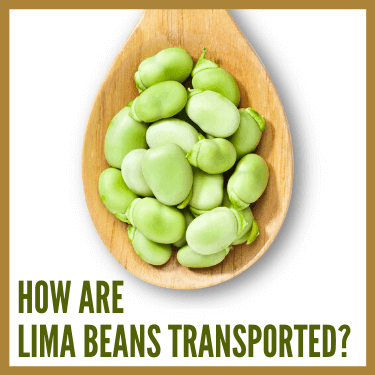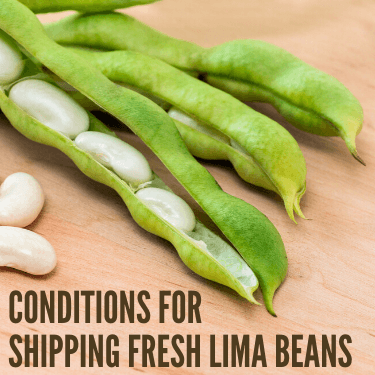With their bright green color and high nutritional value, lima beans can be a good vegetable to include in a balanced diet. In fact, they don’t have to be your boring, old legumes if you get creative. As a grower of the part, you already know that and are instead concentrating on how to transport lima beans to markets around the United States.
While they are a hardy vegetable, when you transport lima beans, they do need certain levels of care. It’s also good to know where they mostly grow and the best process to prepare them for shipment. Even further, during shipping, what the ideal conditions are. Read on to learn how to maximize your lima beans harvest.
One of the smallest states in the U.S. is the largest producer of lima beans, which are also known as butter beans. Delaware, the first state, is responsible for half the acreage — 20,000 — in America dedicated to growing the crop. Lima beans are also grown in other mid-Atlantic states such as Maryland, while California is the biggest producer in the western half of the United States.
It is important to note in California that the dry beans grow best in the San Joaquin Valley, which starts in the central part of the state and nearly goes up to Sacramento. Southern California, with little rain and humidity, isn’t great to try to sprout this particular crop.
Like with many plants, weather conditions account for the biggest factor in determining crop yield for the lima beans. The reason the plant thrives in the mid-Atlantic states is the lower temperatures, higher humidity in the summer months and rain, which is obviously conducive to better soil moisture.
Conversely, heat (especially at night), dry air and little rain will cause yields to be lower because the plant will expel too much energy through respiration to “concentrate” on growing effectively. Tilling the soil will also be productive in further helping ensure a better crop yield.
Lima beans are considered an ideal rotation crop because the plant has several positive qualities while growing:
So while the growth of lima beans isn’t widespread, the plant can be important for several reasons.
Sending other edibles over the miles? Learn more about freight shipping food.

Fresh lima beans are best transported using polyethylene (plastic) bags inside strong fiberboard boxes to keep the produce fresher during shipment. The boxes can be stacked and they are usually waxed on the inside so they don’t get damp and collapse
While still in their shells, lima beans can be stored at between 37 and 45 degrees fahrenheit. The optimal temperature for shelled lima beans is 38 degrees fahrenheit.
As far as frozen lima beans are usually shipped in similar containers, with refrigerated air on the truck but obviously set at 32 degrees or below.
When they are finished growing, lima beans are mechanically harvested with pod stripper combines. Once that happens, fresh beans need to be cooled off and processed rather quickly as they will spoil within a week if just left in their raw state. Like most beans that grow in a pod, if left to heat up, the beans will quickly deteriorate.
If the beans are going to be frozen, the faster they are frozen and bagged, the better for the overall product. Canned lima beans, on the other hand, need to be cooked before they go into the metal cylinders often seen on shelves. That process should take place soon after they are initially processed.

There are a few different conditions that exist for shipping harvested beans depending on what state the beans are processed into. Just remember, lima beans have to be fully cooked and the water they are cooked in must be discarded before consumption. Or else they can make you fairly sick.
For fresh lima beans: Unshelled, fresh lima beans should be refrigerated soon after being harvested. They can stay refrigerated for up to one week between 37 and 45 degrees at 95 percent relative humidity. This would require a refrigerated truck.
For dried lima beans: Once these beans are dried, they can be stored for 2 to 3 years at room temperature and still be of high quality. So just make sure they don’t heat above that during shipping and they’ll be a-ok.
For canned lima beans: These are already cooked and just need to be rinsed off before eating. As far as canned beans go, follow normal conditions for canned goods. Don’t let the cans reach extreme heat and package them in a way that helps prevent the canned from being dented for retail shelves.
For frozen lima beans: The beans will be processed, and then bagged and frozen. They are usually uncooked as well. At this point, the beans should have the cold chain maintained. This means they should remain frozen at every point along the way to grocery stores so that they keep their high quality taste and avoid being refrozen if they were to thaw out. Lima beans can be refrozen; however, customers might not be happy as they won’t taste as fresh being in and out of the freezer multiple times.
Once you’ve decided to transport lima beans, your first phone call should be to R+L Global Logistics. With a wealth of experience in the transportation industry — 30-plus years — we are best positioned to help make your next shipment go off without a hitch.
R+L Global Logistics will make sure your prized crop gets where it needs to go on time and without being damaged, since we have dealt with freight hauling produce all over the U.S. and beyond. To give you further peace of mind, we include real-time visibility of where your freight load throughout its journey.
Speaking more to our vow to be on time, we boast a 99.5 percent rate of timely deliveries, meaning only 1 out of every 200 trucks is not there before or at the agreed-upon time. Our customer service team will handle any issues you have at any stage of the partnership as well.
So once you’re prepared to transport lima beans, elderberries and other freight food, reach out to R+L Global Logistics for a free freight quote on our website or contact us via phone at (866) 353-7178.
R+L Global Logistics
315 NE 14th St., Ocala, FL 34470